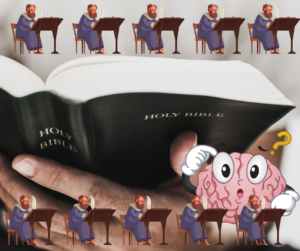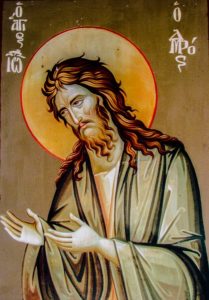Christmas is one of my favorite holidays and has been for as long as I’ve walked this Earth. As a kid, it was because I got a boatload of toys on Christmas morning that I got to play with as Mom and Dad prepared Christmas dinner for us and the rest of my family. As someone who is now a born-again Christian, my primary reason has shifted from getting gifts to praising God for taking on human flesh to begin His mission of redeeming fallen humanity. We all know the story: of how Gabriel appeared to Mary, told her she would become miraculously pregnant with Jesus, how Mary and Joseph traveled to Bethlehem where Jesus would then be born, etc. However, those of us who witness to non-believers will encounter some objections about the reliability of the Christmas narrative.
It is the point of this blog post to wrestle with these challenges to the gospels’ reliability.
1: The Census
Luke 2:1-3 says “In those days Caesar Augustus issued a decree that a census should be taken of the entire Roman world. (This was the first census that took place while Quirinius was governor of Syria.) And everyone went to their own town to register.”
The Bible is clear that Jesus was born when Herod The Great was in power and when Quirinius was governor, but (A) Flavius Josephus says Herod died in A.D 4 and (B) secular history attests that Quirinius didn’t become governor until A.D 6? Did The Bible get it wrong?
First of all, I think we should give Luke the benefit of the doubt. In The Book Of Acts In The Setting Of Hellenistic History, the classic scholar Dr. Collin J. Hemer shows that archeology proves that the book of Acts got it right in 84 incidental details. The first chapter of Luke and the first chapter of Acts both give us clues that these books are written by the same author (Luke), such as the fact that they’re both addressed to a man named Theophilus and in Acts, the writer alludes “to my former work” (Acts 1:1). This is one piece of internal evidence that Luke and Acts had the same author. Now, if Acts gets it right in 84 different places, then is it really reasonable to suspect that this same writer would be so sloppy in his previous work? In fact, the famed scholar and archeologist Sir William Ramsay once said “Luke is a historian of the first rank; not merely are his statements of fact trustworthy, he is possessed of the true historic sense…in short, this author should be placed along with the greatest of historians.” 1Click here to read about some of the things Luke got right in both of his books.
Secondly, there are proposed solutions which could resolve the issue. One proposed solution has been that there were two different men named Quirinius governing on two different occasions. That possibility isn’t entirely out of the question. After all, we’ve had more than one president whose first name is George. The two-Quirinius explanation would be analogous to George Bush’ presidency in the 90s and George W. Bush’ presidency in the 2000s.
Another proposal is that the Qurinius reigned on two different occasions. As Daryl E Witmer of ChristianAnswers.net explains: “There is good reason to believe that Quirinius was actually twice in a position of command (the Greek expression hegemoneuo in Luke 2:2 which is often translated ‘governor’ really just means ‘to be leading’ or ‘in charge of’) over the province of Syria, which included Judea as a political subdivision. The first time would have been when he was leading military action against the Homonadensians during the period between 12 and 2 B.C. His title may even have been ‘military governor.’ ” 2
Either of these proposals would solve the timing of Quirinius’ governorship. Either there were two governers by this name, or, as seems most likely, Quirinius was the governor on two separate occasions. This latter view is the one that archeologist William Ramsay endorsed.3
But what about the census itself? Was this really a practice that the Roman government did?
Here’s a quote from an official governmental order dated AD 104. Gaius Vibius Maximus, Prefect of Egypt [says]:
“Seeing that the time has come for the house to house census, it is necessary to compel all those who for any cause whatsoever are residing out of their provinces to return to their own homes, that they may both carry out the regular order of the census and may also attend diligently to the cultivation of their allotments.” 4
As you can see, that practice is confirmed by this document. And another papyrus from AD 48 implies that the entire family was involved in the census. Moreover, there have been scholars who argued that Romans were known to occasionally allow a census to be taken according to local customs in order to avoid ticking off the population. According to ancient Semitic culture, what this means is that Mary and Joseph would have had to trek to the home of their ancestors.
2: The Christmas Star
In Matthew 2:2, the magi appear before King Herod and ask him where the baby Jesus is. They said “Where is the one who has been born king of the Jews? We saw his star when it rose and have come to worship him.” The Magi knew how to get to the town Jesus was born because a huge shining star in the sky acted like a celestial GPS system. This incident of the star that guided the magi has baffled historians and astronomers for years. What kind of event could this be? What astronomical phenomenon could have occurred in the universe to have caused a star to shine noticeably bright for the duration of the magis’ journey?
Some Christians have responded to this challenge by asking why it even has to be a literal star at all? Why can’t it just be a supernatural light caused by God? Or why couldn’t it be supernatural light given off by an angel? The problem is that the text specifically calls it a star, or at least some kind of celestial body in this universe. The Greek Word translated as “star” is aster, and according to Hugh Ross, this Greek word can indicate a number of different astronomical bodies, including a star, planet, comet, asteroid, or meteor. If we’re to read the plain meaning of scripture, we should probably conclude that this is a star, planet, meteor, or some other astronomical body rather than an angel or a miracle light. This would be to stick to the hermeneutical principle that The Bible should be interpreted literally unless good reasons can be given to take a term metaphorically.
The astrophysicist Hugh Ross once argued that the star was a recurring nova. He wrote “The brighter novae are rare enough that they could catch the attention of the Magi (who, it seems, were waiting for a sign), yet also dim enough to escape the notice of other observers. And, unlike supernovae, a few novae actually can erupt several times.”5
However, he himself said there was “a snag” in this explanation. He said that all the recurring novae that astronomers had observed had a recurrence rate of 10 years or even a century! Nevertheless, Dr. Ross said that believed it was possible for a nova to recur in less than two years. In 2014, new scientific evidence came to light to vindicate Ross. Ross wrote about these findings, saying “Astronomers observed nova M31N 2008-12a recurring within a period of only one year. Following this discovery, a team of four astronomers demonstrated that a certain kind of white dwarf star could exhibit recurring nova eruptions with a period as short as two months. Such a white dwarf star’s rotation rate would need to be close to zero and its mass would need to be 1.38 times the Sun’s mass. It also would need to be accreting mass from a companion star at a rate of 0.00000036 solar masses per year. The team also showed that a one-year nova eruption period requires a white dwarf with a mass = 1.30 solar masses and an accretion rate = 0.00000015 solar masses per year.” 6
3: Herod’s Slaughter Of Innocent Babies
Matthew 2 records that King Herod sought to kill all of the babies in Bethlehem who were 2 years old or younger because he believed the prophecies in The Old Testament about the coming of the Messiah (the giant star talked about in the previous subheader being a sign that he had arrived). Historians and scholars of ancient history have doubted whether this incident ever really occurred. Why? Because the only place it’s recorded is in the gospel of Matthew. Surely a person of such prominence as King Herod committing an act as heinous as murdering all of Bethelem’s infants would have been talked about by more people than Matthew, right?. You would expect Josephus or Tacitus to have at least made a passing reference to this event, right?
What are we to do about this objection? Did King Herod’s genocide not occur? Did Matthew make the whole thing up? Lee Strobel brought this objection up in his interview with Archeologist John McCray in his book The Case For Christ. In that interview, McCray responds with the following:
“‘You have to put yourself back in the first century and keep a few things in mind. First, Bethlehem was probably no bigger than Nazareth, so how many babies of that age would there be in a village of five hundred or six hundred people? Not thousands, not hundreds, although certainly a few. ‘Second, Herod the Great was a bloodthirsty king: he killed members of his own family; he executed lots of people who he thought might challenge him. So the fact that he killed some babies in Bethlehem is not going to captivate the attention of people in the Roman world. And third, there was no television, no radio, no newspapers. It would have taken a long time for word of this to get out, especially from such a minor village way in the back hills of nowhere, and historians had much bigger stories to write about.” 7
So, in other words, Bethelem was extremely tiny so the slaughter wouldn’t have been a major holocaust. Secondly, Herod was known for heinous acts (see the writings of Josephus), and thirdly, it would have taken a long time for this to have circulated. Given the second point, it wouldn’t have probably been of much interest to people outside of Bethelem.
I would add to McRay’s points by pointing out that much of ancient writings have been lost in the sands of time, decayed away. Sometimes portions of these writings survive as citations in other works, such as Thallus’ mention of the darkness at Jesus’ crucifixion quoted in a work by Julius Africanus which was itself quoted by a historian named George Syncellus8. Both Thallus’ and Africanus’ works are lost, but both partially survive in Syncellus’ work. That’s one way we know that they didn’t survive; because historians see these authors quoted yet the quoted works are nowhere to be found. So, it may be the case that some other historians did make mention of it, but their works either haven’t been found yet or none of the manuscripts survived to the present day. We just don’t know.
Conclusion
Archeology and astronomy have helped to shed light on these Christmas Conundrums. We have reason to believe that Matthew and Luke accurately recorded the story of Jesus’ birth.
———————————————————–
Footnotes
1: Sir William M. Ramsey, The Bearing of Recent Discovery on the Trustworthiness of the New Testament, Hodder & Stoughton, 1915.
2: Daryl E. Witmer, “When Did The Luke 2 Census Occur?”, https://christiananswers.net/q-aiia/census-luke2.html
3: John McRay, Archaeology and the New Testament (Grand Rapids: Baker, 1991), 155, emphasis added.
4: William Mitchell Ramsay, The Bearing of Recent Discovery on the Trustworthiness of the New Testament (London: Forgotten Books, 2012, reprint of 1909 edition), 277.
5: Hugh Ross, “Astronomy Sheds New Light On The Christmas Star”, December 1 2014, http://reasons.org/explore/blogs/todays-new-reason-to-believe/read/tnrtb/2014/12/01/astronomy-sheds-new-light-on-the-christmas-star
6: ibid.
7: Strobel, Lee; Strobel, Lee. Case for Christ Movie Edition: Solving the Biggest Mystery of All Time (Case for … Series) (Kindle Locations 2256-2263). Zondervan. Kindle Edition.
8: George Syncellus, quoting Julius Africanus, “History Of The World, Book 3”.
Discover more from Cerebral Faith
Subscribe to get the latest posts sent to your email.




